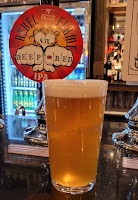
Late October brought the JD Wetherspoon Autumn Beer Festival, as usual. And as usual the Dublin branches didn't launch straight into the specials on day one so I got to do a little preliminary tippling, not that there's any great difference between what's on for the festival and what isn't.
Starting at The Silver Penny, I thought I'd had Kirkstall's
Dissolution before, in York
some years ago, but turns out that was the rye version. Plain Dissolution is 5% ABV and despite the absence of rye, I assume, still lands a sharp and punchy bitterness, thanks to American hop classics Columbus and Chinook. Rose gold in colour, its aroma and brief foretaste are freshly floral in a typically English way. The body is as weighty as one might expect, and that delays the bitterness a little but also makes it last longer when it kicks in: an oily, resinous, malt-fuelled tongue fire that's shocking at first, then delightful, then actually moreish. The English don't brew 5% ABV cask ales for session drinking, so this one must be an accident. It's very good though.
A few days later I headed for Keavan's Port in the hope that they might have tapped up the festival beers, but although the bunting was everywhere, it was not to be. I still managed to get three ticks in, however, so it wasn't a wasted journey.

Well, sort of. The
Butcombe Gold, gold as you like, had a promising honey foretaste, all sweet and floral. The texture is light and the honey is there in the flavour, but... my third had a twang of vinegar about it, strongly suggesting it may have been on a while. It wasn't ruined, but not at its best either. Such is the way of cask. Especially around here.
Next was Jurassic's
Durdle Door, and a description I'd not seen before: "rusty gold". Which is to say, amber. This is 5% ABV, and in the way of such cask beers, tastes stronger, with a rich clove and raisin flavour. That matches with the full body and warming vapours. It doesn't cloy, however, finishing quickly and drily with refreshing tannins, the saviour of many a brown bitter. This is really an enhanced one of those, and definitely nothing fancy, but tasty nonetheless.
Lastly, it's Sambrook's and their porter,
Powerhouse. It's always great to welcome a porter, on cask, to my face. It's a sort of cola-esque ruby-brown and has a very faint aroma of caramel with something spicier, like root beer. The texture is light and the flavour quite plain, starting on nothing, before gradually brightening to caramel, milk chocolate and that sassafras effect again, with maybe a lacing of marzipan. It made me work to find those descriptors, and I resent that slightly. I get that a porter, even at 4.9% ABV, should be down-the-hatch drinkable, but that's no reason for it not to be flavourful. More wallop would be welcome.

My first actual festival beer, and the only international collaboration I found, was
Telemark Rav, a red session IPA with Norwegian Telemark Bryggeri as the guest collaborator and production happening at Shepherd Neame. I'm generally suspicious of Shepherd Neame beers but this one charmed me from the outset with a fresh lemon and toffee aroma. There's a touch of the house character about the flavour -- a bitter orange rind effect -- but it gels well with the dark malt and fruit candy hops. My first impression was that they're American varieties but it's actually an all-British line-up: Jester, Olicana, Ernest and Godiva. If the intention was to breed a combination that brings an American feel to smooth cask ale then it absolutely worked. This is no barnstormer (it's a while since I found a memorable beer at these festivals) but it's jolly decent, giving a solidly reliable malt base some bright hop topnotes, finishing dry for actual sessionability despite the sizeable 5% ABV.

Another porter next:
Astronomer by Black Sheep. This dark brown affair is 4.2% ABV and brewed with chocolate. For all that it's quite dry with a significant bitterness; all classy dark chocolate rather than pastry dessert. Metallic and vegetal notes vie for prominence in a very grown-up flavour profile, before a savoury finish with more than a touch of umami or even putty. I liked the strength of character here. It's a challenging beer rather than an easy drinking one. Although, since I went in expecting something fun and quirky or smooth and mellow, it was still a bit of a disappointment on those grounds.

White IPA is a style I rarely warm to, and I still associate the next brewer, Bath Ales, with horrific levels of diacetyl, a problem they have successfully resolved since the brewery changed hands a few years back. Still it was a surprise how much I enjoyed their
White Rabbit. Uncharacteristically for the style it's perfectly clear -- a pale shade of gold. There's none of the soapy clash of herbs and hops and instead a lightly fruity mix of pear skin and apricot. They've achieved this, somehow, using Cascade and Amarillo, making them perform fun tricks that are out of character but very entertaining. Most amazingly it's all done at a mere 3.6% ABV. A solitary half pint did it no justice at all.

Returning to Shepherd Neame, under their own brand they had
Rebel Flame, described as a red IPA but nothing of the sort. For one thing it's a very pale amber colour and the hops are by no means punchy or bitter. Instead it appears to be depending heavily on the complexity of the brewery's distinctive house yeast. That gives it a sweet and greasy make-up bag aroma leading on to flavours of black pepper oils, sandalwood and citrus peel. Despite seeming resinous it's nicely dry, and mercifully missing the rotten wood effect that usually turns me off Shepherd Neame beers. I didn't think I was going to like this and, as with the White Rabbit, was very pleasantly surprised.

Two golden ales followed on a later visit to Keavan's Port, beginning with Hogs Back
Home Harvest. This is the slightly darker of the pair, touching on amber. It's a mere 4% ABV and light without being thin. The flavour is fairly sweet, with a candy mix of bubblegum and banana. There's a certain dryness, but not enough to balance the rest, and I was finding it sickly before I was half way through my half. It seems as though an attempt to make a bitter more approachable and less bitter has gone awry here.
Paler but stronger beside it is the 4.6% ABV
Olicana, one of many British beers named after this new hop variety. This is another slightly sticky one but it handles it better by ramping up the tannic dryness and adding a definite bitter aniseed kick on the end. Before that, it's a fun mix of peach nectar, white grape and almonds. The sweet side leaves the palate after a respectable time and it's the dry bitterness which lingers on, infinitely preferable to sticky residual sugar.

Fyne Ales is normally a good bet and their contribution was
Substructure, described as a tropical session IPA but looking like a witbier to me: pale yellow and lightly hazy. There's a bit of witbier about the aroma too, which is primarily zesty like lemons. It does turn tropical on tasting, however, with softly juicy mango and cantaloupe in the middle. Sadly it's short-lived; I would have liked more depth and a longer finish: not an unreasonable request when the beer is 4.3% ABV. Instead it bows out on a citric bitterness with a faintly soapy twang. Regardless, this is rather good and up to the standard I expect from the brewery. The two flavour aspects delivered by the hops are particularly unusual to find in a single beer.

Finally, another beer named after a new English hop variety:
Jester, from Suffolk brewery Green Jack. This is a golden ale of 4.4% ABV, and yes, it's golden. It's a while since I last had an all-Jester-hopped beer so can't quite remember how it's supposed to taste, other than broadly like a new-world variety. This has an earthy citrus, not dissimilar to Cascade, itself descended from English Fuggles, of course. There's a fun bubblegum side as well. The hopping isn't very striking however, offering a muted presence which is still essentially English. The underlying beer is dry and quite grainy. Overall, it's a good effort but not really my sort of thing. There's room for some extra malt sweetness for sure: a bit of honey or golden syrup would be welcome, but howanever.
Eight out of 30 festival specials is an acceptable hit rate, though I'm missing a few particularly intriguing ones from the programme. Now that the chain has a commitment to Irish cask beer I have high hopes of something from Dungarvan and/or Brehon in the Spring Festival when that comes around next year.
 I have a huge collection of backlogged Irish beer posts sitting waiting to be tidied up and slotted into the schedule. To buy myself some time it's just one today: Coco Buzz, a stout from Trouble Brewing. 5.6% ABV with added coconut and hazelnut.
I have a huge collection of backlogged Irish beer posts sitting waiting to be tidied up and slotted into the schedule. To buy myself some time it's just one today: Coco Buzz, a stout from Trouble Brewing. 5.6% ABV with added coconut and hazelnut.








































